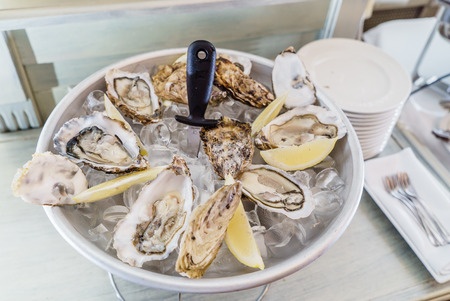
The humble oyster used to be regarded as peasant food in the Middle Ages. A tasty treat to be collected from the estuaries of France and the UK. It was certainly not the lover’s food we think of for St. Valentine’s day. In fact there is no scientific evidence whatsoever that oysters were even aphrodisiacs. It is however the classic starter to a large meal especially in France. It’s also the ultimate food luxury along with truffles, wagyu beef and caviar and ranks consistently in the top 10 most expensive foods.
The myth that oysters had special powers comes from the Romans who believed it was the equivalent of the more modern concept of Dutch courage. Enhancing sexual desire was more than just a trope for 18th Century lovers. Casanova who ended up in the Doge’s Venetian prisons swore by its properties having eaten 50 of them for breakfast and given his predilections.
To many there are but a few places that we would regard as the best for tasting fresh oysters. There are five true oyster species to think of and each has its own peculiarities in taste and flavour. The main species for most in the States is the Atlantic Oyster (Crassostrea virginica) whose distribution extends from the Gulf of St. Lawrence to as far as the Gulf of Mexico and the West Indies. For many who went to New York, oysters had to come from Chesapeake Bay and it still provides a large bulk of produce even if supply has dropped off in recent years. If you cross over to the Pacific side, then consider the species originally from Japan. This is the aptly named Pacific Oyster (Crassotrea gigas) which now lives all along the Pacific coast line of the States.
The Flavour of Oysters
Strangely, there isn’t a lot of sensory research on oyster flavour. It is however known by officionados that the flavour of raw Pacific Oysters have a distinctive cucumber and melon like note to them. The Atlantic Oyster is more seaweed like. If you delve into the chemistry there are few references to help us and it was reasoned that same principles that applied to the flavour of fish has to apply to this notorious bivalve.
In the first instance, the flavour quality of an oyster depends on a few key features. They don’t move ! They obtain all their food by filtering sea water through their gills and so they can accumulate whatever they like including toxins, metals, etc. The environment has an immediate impact on their quality and frankly how safe they are to eat. I’m not going to discuss the fact they are the primary source of Shigellosis simply because that is a topic in its own right. It is fair to say that if they don’t smell right or lack the creamy, almost ivory like colour then they should be avoided at all costs. Colour plays a vital role here in appearance, acceptance and presentation of the oyster as with fish and other shellfish. It has been intensively studied (Harada, 1991; Young and Whittle, 1985) because if we don’t trust the colour of this particular product then it will not even get past the lips.
A definitive assessment is that by Josephson (Josepheson et al., 1985) who compared the aromas of fresh Atlantic and Pacific oysters. It’s a benchmark study which looks at the main differences between the two. The volatiles extracted were rightly deduced to come from the enzymatic oxidation of PUFAs (polyunsaturated fatty acids) (Josephson, 1991). The cumber and melon notes described earlier were due to various 9-carbon molecules with low odour thresholds such as 2,6-nonadienal and 3,6-nonadien-1-ol. Any slightly sulphurous notes were down to compounds like dimethyl sulphide which has an extremely low aroma threshold. A little later, oyster extracts from C. gigas were collected using either vacuum hydrodistillation or dynamic headspace. The former method was better at producing an extract closest to oyster (Pennarun et al., 2002a) when a trained sensory panel examined them.
Vacuum steam distillation was also used to prepare extracts for chemical analysis (Pennarun et al., 2002b). Fifty-nine volatiles were identified of which 25 were responsible for the overall odour. Four compounds were linked to a fresh and marine odour: 3-(E)-hexen-1-ol, decanal, 2-undecanone and 3,6-(E,Z)-nonadien-1-ol. Some compounds were identified for the first time in this bivalve such as 4-(Z)-heptenal which is reminiscent of white boiled fish. This derives from n-3 polyunsaturated fatty acid oxidation. They also identified 3-octanol responsible for a moss and sulphury odour, 2-nonanol (cucumber odour) and octanoic acid, which come from n-6 polyunsaturated fatty acid oxidation.
If you know the odour of fresh oysters, then it is logical to understand what happens when they become ‘iffy’! Shucked oysters (ones which have been removed from their shells) have a much shorter shelf-life because their nitrogen levels rise, are prone to bacterial attack and have a high muscle pH.
Zhang et al., (2009) at Fuzhou University in Fujian, China looked at the changes to 27 volatiles occurring to oysters deteriorating. There methods involved headspace solid-phase micro-extraction (HSSPME) and steam distillation (SD), with GC-MS detection. A succinct profile showing the compounds disappearing and forming proved useful for quality analysts. Subsequently, a more involved study of the bacteria producing spoilage off-notes in oysters showed precisely why we are put off bad bivalves (Madigan et al., 2014). The flora and fauna of oysters is expertly reviewed by Chen et al., (2016).
We’ll look at Vibrio and High pressure Processing for shucking oysters in other articles.
Where do you find the most expensive oysters?
The world of oysters boasts a variety of species and locations that contribute to that wonderful diversity of flavours, textures, and naturally prices. When it comes to the most expensive oysters, certain regions are renowned for producing these sought-after delicacies. Some of the notable places where the most expensive oysters come from are found in these places – we can never vouch for the actual price because of their seasonality.
- Belon Oysters (European Flats): These oysters, often considered some of the most expensive, come from the Belon River estuary in Brittany, France. They are known for their distinct metallic flavor and are highly prized by oyster connoisseurs.
- Kusshi Oysters: Originating from the Pacific Northwest of North America, particularly from regions like British Columbia, these oysters are small, deep-cupped, and have a clean, slightly sweet flavor. Their slow growth and unique taste contribute to their premium price.
- Sekoma Oysters: Grown in Sekoma Island, Japan, these oysters are cultivated using traditional techniques. They are known for their creamy texture and rich umami flavor, making them a sought-after luxury item.
- Ostra Regal: Hailing from Ireland, these oysters are grown in the pristine waters of the Atlantic Ocean. They are celebrated for their complex flavor profile and clean, briny taste.
- Fanny Bay Oysters: Produced in the Fanny Bay area of British Columbia, Canada, these oysters are characterized by their deep cups and mild, slightly fruity flavor. Their consistent quality and unique taste make them a premium choice.
- Merimbula Oysters: Cultivated in the pristine waters of Merimbula Lake in New South Wales, Australia, these oysters are known for their clean and crisp flavor, as well as their meaty texture.
- Galway Bay Oysters: Grown in the cold waters of Galway Bay in Ireland, these oysters are recognized for their intense brininess and oceanic taste, making them a popular choice among seafood enthusiasts.
- Tasmanian Oysters: Tasmania, an island state of Australia, is renowned for its high-quality seafood, including oysters. The clean waters contribute to the development of plump, flavorful oysters that command a premium price.
- Wellfleet Oysters: Originating from Cape Cod, Massachusetts, USA, these oysters are celebrated for their balance of saltiness, sweetness, and mineral notes. Their unique flavor profile contributes to their popularity and higher cost.
- Pemaquid Oysters: Sourced from the Pemaquid River area in Maine, USA, these oysters are known for their distinctively salty, mineral-rich taste and smooth texture.
The Best-Value Oysters
For some of us, the most expensive oysters might not be good value. There are a number of suppliers of oysters who would meet the more modest demands of the purse. These are:
- Malpeque Oysters (Crassostrea virginica) (Prince Edward Island, Canada): Malpeque oysters are known for their clean, briny but balanced flavour and are often considered a budget-friendly option.
- Blue Point Oysters (Crassostrea virginica) (Long Island, USA): Blue Point oysters are a popular choice due to their mild, slightly sweet taste and reasonable price.
- Kumamoto Oysters (Crassostrea sikamea) (Washington State, USA): These oysters were originally from Japan but now cultivated in the colder waters of Anacortes. They have a deep cup and a rich, buttery flavor profile, making them a good value for their taste.
- Hama Hama Oysters (Washington State, USA): Hama Hama oysters are known for their robust flavor and moderate pricing compared to some other premium varieties.
- BeauSoleil Oysters (New Brunswick, Canada): BeauSoleil oysters are praised for their consistent quality and delicate taste.
- European Flat Oysters (Ostrea edulis): Found along the coasts of Europe, these oysters have a distinct flavor and are often considered more affordable compared to some gourmet varieties of the same species.
- Eastern Oysters (Crassostrea virginica): Widely cultivated in North America, Eastern oysters are known for their briny flavor and are often more budget-friendly than some other varieties.
- Pacific Oysters (Crassostrea gigas): These oysters are native to the Pacific coast and are commonly farmed, making them relatively affordable and widely available.
It’s important to note that oyster prices can vary based on factors such as size, flavor, rarity, farming techniques, and the overall demand for premium seafood. Additionally, the appreciation of oysters is a highly subjective experience, as individuals have varying preferences for taste and texture. As a result, the most expensive oysters often emerge from regions that have successfully cultivated oysters with unique and prized characteristics. .
References
Chen, H., Liu, Z., & Shi, Y., Ding, H. H. (2016). Microbiological analysis and microbiota in oyster: a review. ISJ, 13, pp. 374-388 (Article)
Harada, K. (1991). Fish colour. Australian Fisheries 50, pp. 18−19
Josephson, D. B. (1991) Seafood. In: Volatile Compounds in Foods and Beverages; Dekker: New York, pp 179-202.
Josephson, D. B., Lindsay, R. C., Stuiber, D. A. (1985) Volatile compounds characterizing the aroma of fresh Atlantic and Pacific oysters. J Food Sci. 50, pp. 5-9
Madigan, T. L., Bott, N. J., Torok, V. A., Percy, N. J., Carragher, J. F., de Barros Lopes, M. A., & Kiermeier, A. (2014). A microbial spoilage profile of half shell Pacific oysters (Crassostrea gigas) and Sydney rock oysters (Saccostrea glomerata). Food Microb., 38, pp. 219-227.
Pennarun, A.-L., Prost, C., Demaimay, M. (2002a) Aroma Extracts from Oyster Crassostrea gigas: Comparison of Two Extraction Methods. J. Agric. Food Chem., 50 (2), pp 299–304 DOI: 10.1021/jf0105687
__________________________________(2002b) Identification and origin of the character-impact compounds of raw oyster Crassostrea gigas. J. Sci. Food Agric. 82 (14) pp. 1652-1660 DOI: 10.1002/jsfa.1236
Young, K. W., & Whittle, K. (1985). Colour measurement of fish minces using Hunter L, a, and b values. J. Sci. Food Agric., 36, pp. 383−392 (Article)
Zhang, Z., Li., T., Wang, D., Zhang, L., Chen, G. (2009) Study on the volatile profile characteristics of oyster Crassostrea gigas during storage by a combination sampling method coupled with GC/MS. Food Chem., 115 (3) pp. 1150-1157
Amended from article 02/02/2017 to include top 10 and value-for money oysters.


Leave a Reply